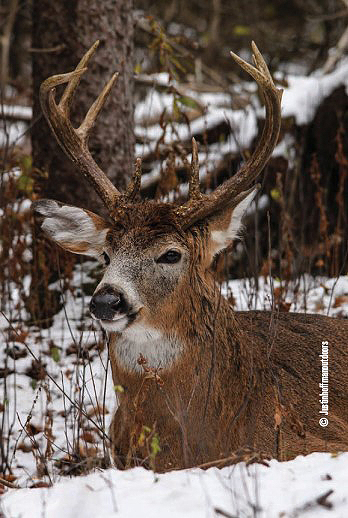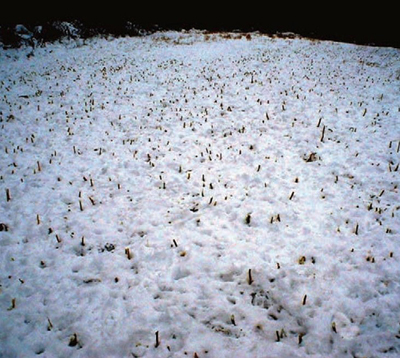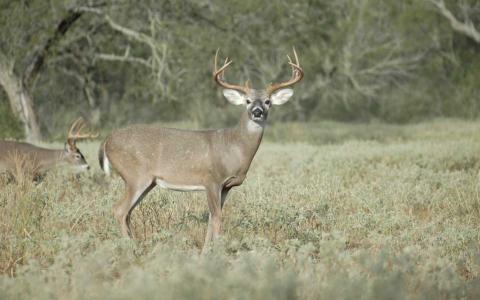Todd Amenrud | Originally published in GameKeepers: Farming for Wildlife Magazine

metabolism actually slows down during winter. The
author believes it does, but the reason they
consume less food and are less active during
winter is also due to the facts they have adapted
specific physiological and behavioral
transformations.
It boggles my mind to think about what whitetails have to go through to survive a winter, especially in the northern most states and Canada. I’ve been in my late season tree stand with below zero temperatures, clad in wool and special garments with the latest “cold weather technology,” with disposable hand warmers jammed in every pocket and extra warmers shoved wherever they would fit, yet still wound up cold and shivering, wondering how any living creature could survive these conditions for a day…let alone an entire winter.
So, how do deer survive in the winter? God definitely fashioned a magnificent creature in the whitetail and gave them some unique features, physiological functions and behaviors that aid them in surviving the frigid, harsh conditions.
A Shield from the Elements
A whitetail’s physiology maintains their body heat at 104 degrees Fahrenheit throughout the year. While their summer coat provides protection from the sun and helps keep the animal cool, their winter coat’s job is to insulate against the cold. The hollow guard hairs provide protection and insulation, but it’s really the finer, wool-like hair underneath that affords the greatest insulation value. There aren’t as many outer guard hairs but they are hollow, thicker and twice as long. Their inner coat contains over 5,000 hairs per square inch and works incredibly well at insulating their body.
The outer guard hairs also have a couple important jobs - they trap air and create their own water repellent to keep the hairs underneath dry. Connected to each hair follicle is a small “sebaceous gland” that secretes an oily substance called “sebum.” The sebum coats the hair to help it shed water. You may have seen snow build up on a deer’s back without melting. With a body temperature over 100 degrees that’s made possible because of their coat’s excellent insulation and water-repelling qualities. In addition, their winter coat is dark-brown or gray and absorbs more solar energy. So their well-designed coat not only soaks up heat, it insulates against temperature loss and energy expenditure.
Chubby Wubby
In modern times people exhibiting “fat stores” on their person typically receive a very negative reaction from others. However, several hundred years ago that wasn’t the case. In fact, plump women were considered much more attractive than skinny women, as depicted in many paintings of the period. It probably had a lot to do with humans before them and the simple act of survival. More fat stores meant a better chance at continued existence. For whitetails, that’s what it’s all about – “survival!” Going into winter with ample fat reserves means they have a better chance emerging from the end of the “long winter gauntlet” alive.
Fat is essentially “concentrated energy.” Fat reserves can provide much of a whitetail’s required wintertime calories. A whitetail entering winter with ample fat reserves can withstand a 30% weight loss and still survive. The problem comes in our northern states where whitetails come out of breeding and straight into winter without time to recoup the fat that was burned off during the rut. They cannot survive on stored fat alone so browse and wintertime food sources can be very important, not only for deer winter survival, but also for how they fair for the entire year to come. Antler growth can be dramatically reduced because of this “energy depletion” and the stress associated with it during the winter.
Foods like acorns, brassicas and corn can help whitetails to accumulate the necessary fat reserves to pull them through the winter. Once winter hits, browse species become a more important part of their diet. A “double barrel approach” of both, natural foods and food plot crops, should be considered. Foods that bring them into winter healthy, foods that can support their high energy levels through the rut and into winter, and foods that will help them to recoup from rut related stress and winter depletion are all important if you wish your herd to realize their rightful potential.
In addition to the food plot crops mentioned above, whitetails will also need browse. Browse is terrible nutrition when compared to food plot crops, but whitetails must have it. It depends upon the browse species, but only about 25 to 30% of browse is digestible, where 50 to as high as 80% of food plot crops are utilized. The initial nutritional content of browse species is also much less than food plot crops, but whitetails must have browse, it is an important part of their winter diet.

to use, but will often stop using areas once the snow gets
15 inches or more, or compacted and crusted. Making trails
to new browse areas with an ATV or snowmobile can be
very beneficial to your herd.
Simmer Down Now
Some experts say that a whitetails’ metabolism slows down during winter, but it’s been debated in recent years that it may not actually be the case. The different sides of the debate may come from the specific meaning of “metabolism.” If you examine the definition of “metabolism,” that may be true, their actual metabolic rate may not decrease, but I believe it does. (Metabolism is; the sum of the physical and chemical processes in an organism by which its material substance is produced, maintained, and destroyed, and by which energy is made available.)
Regardless of what you call it, a decrease in their metabolic rate or something else, there is no question that during the winter they are much less active and they consume less food. To me it seems as if they’re almost in “semi-hibernation.” The reason they are much less active could simply be the fact they normally intake less energy during this period. You can’t drive 200 miles on two gallons of fuel (at least not with a normal, common-sense type of vehicle). Consider instead of whitetails changing their metabolism during winter, it may be that they have adapted specific physiological and behavioral changes to survive winter’s wrath.
Weather plays a huge role in how active whitetails are (all year long, let alone during winter). Temperature, wind, barometric pressure and precipitation all have an impact on how active they will be. In the wake of a snow storm, I have watched a small herd bed down for almost three days straight without getting up to feed - despite the fact there were ample food plot crops within 200 yards and a corn feeder within 50 yards of their bedded location. I believe in this case their instincts probably tell them they are likely to burn off more energy than they intake.
Security in Numbers
Whitetails will also begin to group up during winter. It may be the fact that they all search out the same type of wintering area, or maybe they have learned there is security in numbers. The more animals there are, the odds of a predator selecting one declines. In addition, you have the obvious benefit of extra eyes, ears and noses to detect approaching predators.
Even mature bucks that spend a good majority of the year in solitude or with a bachelor group seem to live in close proximity to the other deer during the winter. In northern regions you may have herds that number in the hundreds, especially during the late winter and early spring when food sources are very limited. More animals also attract more predators, but there’s no denying there’s better security in numbers.
The Search for Shangri-La

and brassicas can help your herd recoup from the rut and
bring them into spring in good shape to reap the rewards of
excellent spring and summertime nutrition. This small
brassica plot has been eaten to the ground.
Whitetails will also increase their odds of survival by searching out special areas, often referred to as “deer yards.” These wintering areas will be protected from the elements, have thermal cover, ample browse species and oftentimes consist of low-land where mature conifers meet areas of heavy browse. The search for a wintering area may lead an animal a few hundred yards to the nearest south facing slope on up to many miles away.
In the north, evergreen swamps are known for making great winter deer yards. They provide protection from harsh winds and extremely important thermal cover. Thermal cover is simply “shelter that captures heat from the sun.” Conifer trees like cedar, red and white pine, spruce and hemlock provide excellent thermal cover because the dark green foliage absorbs the heat from the sun. Red oak trees, because they hold their brown leaves through winter can also offer this thermal effect.
Good wintering areas will also usually have escape cover and/or security cover -where they can flee or remain hidden from predators. In areas with wolves I’ve seen whitetails actually move close to humans – they have learned that closer to humans means fewer wolves. It can also mean easier travel on snowmobile tracks or plowed trails.
A Helping Hand
There are a number of things that we can do to aid deer winter survival. Even in the south where mortality isn’t as severe, the stress that accompanies winter can be a test to your management abilities. Help your herd through the winter so they are able to reap the rewards of the nutritious spring and summer food sources rather than having to play catch-up when the time comes and never being able to reveal their true genetic potential.
Obviously we can ensure better health and survival for our herd through providing the best food sources possible all year long. We all know that planting food plots and enhancing your native vegetation will reap huge rewards. Consider the times of the year when your herd is in most need of the nutrition and plant for that. Clearly you must have adequate acreage to feed the density in your region, but food is one of the four most important components of a management program and especially vital for winter survival.
Specifically during winter months, felling, or even hinge cutting, browse species can pay huge dividends. If you can put a few new softwood treetops within reach of your herd’s mouths it can immediately do them a world of good. I have watched whitetails come to the sound of a chainsaw because of this. They have learned that the sound of a chainsaw means food – they wait 50 to 100 yards away until you step away from the newly downed tree top and then attack it.
A supplemental feeding program can help maintain equilibrium in a year-around nutrition program. I’m not talking about supplying supplemental feed only during winter; I would suggest free-choice feeders all year long (where legal). I like Record Rack products, they have several well designed products to give your animals what you need for specific goals and during different times of the year.
Where snow is received, make travel for your herd easier by creating trails with a snowmobile or ATV. Up to a foot of snow depth really isn’t a problem for the long legs of a whitetail, but as the snow pack grows denser, crusted or much deeper it becomes precipitously more difficult for them. Deer keep well-used trails packed down, but when snow depths become 15 to 20 inches or more, it becomes very difficult for them to travel off of the trails where the majority of food is located, especially for younger deer. Often they will totally avoid traveling through areas where the snow depth is over 20 inches; this means they may not access areas with prime browse.
Extraordinary amounts of energy are used when whitetails have to travel through deep snow. In addition to energy loss and not being able to access certain food sources, predators like wolves, coyotes or bobcats can travel much easier across the snow-pack. They can displace their weight with paws that have more surface area contacting the snow. These predators run across the crusted snow while the deer bust through and struggle with each step. This is another reason to create trails for your herd when the snow depths demand it.
It is often difficult to battle Mother Nature, especially during winter. A manager should hope for the best, but plan for the worst. A whitetail is an incredible animal with many special qualities that help them survive winter’s nastiest, but a well-designed management strategy will go a long way. A good plan will make sure your herd heads into winter in good shape, take into account your herd’s needs during winter and will help them recoup from winter stress as soon as possible in the spring.






























